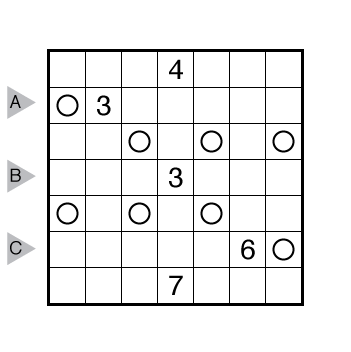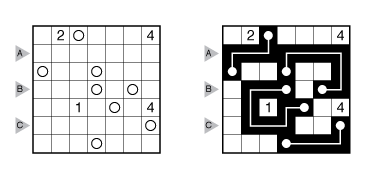Golem Grad by Serkan Yürekli

or solve online (using our beta test of Penpa-Edit tools; use Tab key to alternate between line drawing and shading)
Theme: Clue Symmetry and Logic
Author/Opus: This is the 58th puzzle from our contributing puzzlemaster Serkan Yürekli.
Rules: Variation of Nurikabe. Shade some empty cells black so that the grid is divided into white areas, each containing at most one number. A white area with a number must have the same area in cells as that number. White areas may only touch diagonally. All shaded cells must be connected with each other, but no 2×2 group of cells can be entirely shaded. Also, all shaded cells must be divisible into snakes with the heads and tails given in the grid. Snakes cannot cross each other.
Also, see this example:

Answer String: Enter the length in cells of each of the black segments from left to right for the marked rows, starting at the top. Separate each row’s entry with a comma. This example has the key “7,32,31”.
Time Standards (highlight to view): Grandmaster = 0:45, Master = 1:15, Expert = 2:30
Solution: PDF
Note: Follow this link for other variations of Nurikabe and this link for more classic Nurikabe. If you are new to this puzzle type, here are our easiest Nurikabes to get started on.

An interesting variation, thanks!
When I first started working it, it felt a little inelegant, (as if there were too many different constraints to have to keep in mind). But as I started using the snake constraint together with standard Nurikabe solving, I found it quite satisfying. V znl unir fbyirq guvf cnegvphyne chmmyr jvgubhg rire hfvat gur gjb-ol-gjb pbafgenvag.
-Carl
These rules work well together, giving interesting deductions (e.g. around the edge), I look forward to the larger/harder grids.
There’s one thing I’m missing in the rules, although it didn’t come into play here. Must the division into snakes be unique?
Is the term “snake” defined anywhere? I just noticed that one of the snakes in the example touches itself near its head, which is not permitted in typical “snake” puzzles.
Snake is a playful puzzle word that really just means “path”, and specifically not “loop”. To put more formal words to it: “A snake is a one-cell wide path, traveling from one cell to another distinct cell, that does not cross itself.” This is the only consistent meaning for the term as puzzles from “classic” Snake puzzles to others like hebi-ichigo use.
Snake does not imply a specific “don’t touch” rule by itself, but individual genres will add in edge touching or corner touching as not permitted. Here we are clear to say it is just non-crossing.
There is no requirement that the snake assignment be unique. But in practice it will almost certainly be so. Just as with variations that involve, say, tiling a grid into dominoes, the primary goal here is about shading the grid, not about defining a specific snake arrangement.
When I first saw the rules I figured it would not be much different to a regular Nurikabe. Then I discovered that the snake rules added all sorts of interesting new logic to the mix. Good variation. I also think this was a good puzzle to introduce the type. 🙂
– Neelix